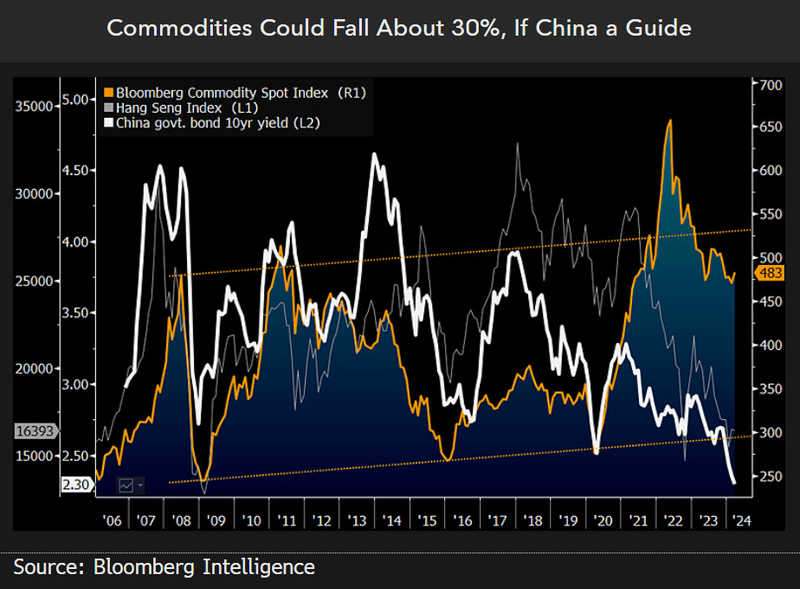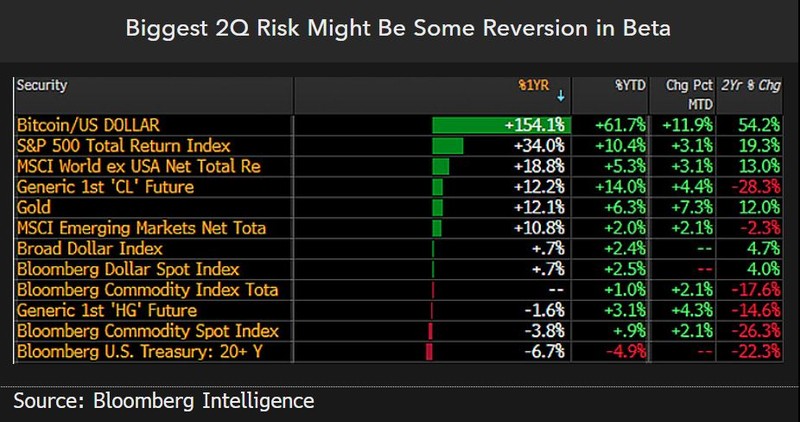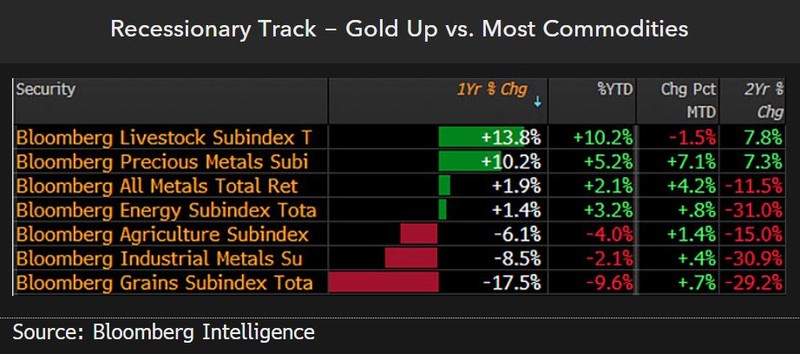This analysis is by Bloomberg Intelligence Senior Macro Strategist Mike McGlone. It appeared first on the Bloomberg Terminal.
The Bloomberg Commodity Spot Index’s almost 1% 1Q gain was buoyed by the S&P 500’s total return around 10%, yet pressured by a deflating China, which could augur 2024 risk leanings. Falling government bond yields and stock markets in China (the top commodity consumer) may follow reversion lessons of rapid emerging markets, particularly when they upset their top export customers (US and Europe) via “unlimited friendship” with Russia.
Record highs in gold vs. most commodities reentering pre-pandemic ranges is consistent with our view for deflation that typically follows the liquidity and price pumps to the 2022 highs, and the tilt toward a great reset. WTI crude oil and copper might have neared 2024 highs in 1Q, and a top potential domino-tumbling risk is some back-and-fill in US stocks.
Bloomberg Intelligence: Data-driven research
Gold and commodities 1980 vs. 2022: Break-even cost low probing
The pattern of inflation and commodity peaks in 1980, then rapid reversion as unemployment rose, may have parallels to now. Typical commodity cycles remain unfavorable for prices, and a top headwind could be evidenced by plunging government bond yields and falling stock markets in the primary consumer — China. Gold outperformance appears enduring.
China deflation could trickle down to commodities
If the Chinese economy can recover promptly this year, commodities might stabilize. Our bias is with the typical process of probing for break-even cost lows following the high-price cure extremes from 2022 peaks. The chart shows deflation in China, evidenced by government 10-year yields at the lowest in our database since 2006 — about 200 bps below US Treasuries — and the falling Hang Seng Index. Bounces from extended lows are normal, but what’s notable from our graphic is the relative elevated Bloomberg Commodity Spot Subindex.
A next potential commodity shoe to drop is crude oil following natural gas, corn, wheat and lumber and heading toward $50 a barrel. WTI crude likely needs to sustain above $83 and copper $4 a pound to indicate strength. An inordinate burden may rest on the US stock market to keep rising.

What does 1980 mean for commodities in 2024?
On the back of the sharp spike to the 2022 peak akin to 1980, the consumer price index declining below a rising US jobless rate is a recessionary blend, with implications for commodity prices, if past patterns are a guide. Our graphic shows the Bloomberg Commodity Spot Index falling toward its uptrend line from the 2009 low and following a similar trajectory as CPI. The distortions of the pandemic, biggest liquidity pump in history and Russia’s invasion of Ukraine are playing out via downward-reversion paths in commodities and inflation, and upward in the unemployment rate.
Given there’s plenty of room for unemployment to rise from multi-decade lows after the unprecedented swift Federal Reserve tightening from zero, along with China in decline, commodities may be more likely to keep deflating than recover this year.

Commodities might stabilize if US stocks keep rising
A top risk for most markets, particularly macroeconomic-sensitive commodities crude oil and copper, is a bit of reversion in the about 10% S&P 500 1Q total return. Deflating commodity prices have companionship from most of the world bending into recession, as seen in declining government bond yields, and risks of some reversion in the elevated US stock market. Gold is the only major commodity setting record highs in 1Q, which could show the metal sniffing out global recessionary leanings.
Colossal gold buying, notably from China, appears entrenched, as does the resumption of range trading in most commodities. Probing for break-even cost lows typically follows high-price cure cycle highs and the greatest volatility major commodity — natural gas — may be the low-price cure leader.

Commodities probing for break-even cost lows
The most price-to-supply elastic grains on the bottom of our annual performance scorecard is consistent with commodities probing for break-even cost lows on the back of 2022 peaks. Absent a poor Corn Belt growing season, corn, soybeans and wheat are on track to follow natural gas to levels low enough that will reset excesses of supply vs. demand due the high-price cure. We see corn more likely to head toward $4 a bushel than sustain above $5, and soybeans toward $10 a bushel, with good resistance at about $13.
Copper and crude oil are the top commodities that need to go up, prove strength and counter global recessionary leanings. Risks are they won’t. Our tilt is that the 1Q highs — $83.85 a barrel in WTI and $4.16 a pound in copper — might mark the upper end of 2024 ranges.





